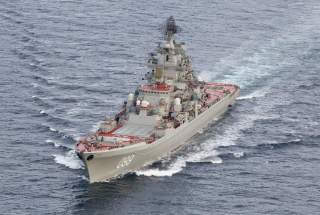Refurbished Like New? the Russian Navy Is Getting Old Kirov Battlecruisers Back Online
Everyone makes do with what they've got.
Key point: These large warships still can cause a lot of damage. However, generally, the Russian navy is downsizing and upgrading what it has.
The Russian navy in three years expects to receive a refurbished, upgraded Kirov-class nuclear-powered battlecruiser, likely doubling the fleet’s complement of the huge ships.
This first appeared in June 2019 and is being reposted due to reader interest.
But two other old Kirovs are slated for dismantling. And the Russian navy’s overall transformation into a smaller force with mostly smaller vessels probably will continue.
Sevmash shipyard will deliver the Kirov-class Admiral Nakhimov to the Russian Navy in 2022, yard chief Mikhail Budnichenko told TASS at the Army-2019 international military and technical forum on June 27, 2019.
"The cruiser’s delivery to the navy will take place in 2022," Budnichenko said.
Work on the cruiser’s hull is complete, Budnichenko added. “Shipbuilders are loading systems and mechanisms onto it.”
The 826-feet-long, 24,000-ton-displacement Admiral Nakhimov originally entered service in 1988. The ship has been at Sevmash since 1999. Refurbishment began in 2013. Current upgrades include the fitting of Kalibr and Oniks cruise missiles.
While Admiral Nakhimov could serve for decades to come alongside sister ship Petr Velikiy, the Russian navy reportedly has decided to dismantle two other laid-up Kirov-class cruisers.
The recycling of Admiral Ushakov and Admiral Lazarev could accelerate the fleet’s evolution into a leaner but more modern force.
The 1980s-vintage Kirovs by far are the largest surface combatants in the world. The Soviet navy planned to deploy them against American carrier battle groups and supply convoys.
The big, missile-armed ships are expensive to maintain. Soon after the collapse of the Soviet Union, the Russian navy laid up Admiral Ushakov, Admiral Lazarev and Admiral Nakhimov. As recently as 2014, the fleet planned to repair and return to service all three of the vessels.
But that has proved too costly for the cash-strapped Russian navy. Admiral Nakhimov’s refurbishment likewise has been slow and difficult, according to Russian Defense Policy.
In mid-2013, the [ministry of defense] gave Sevmash a contract for Nakhimov’s repair and modernization. It was supposed to return to the fleet in 2018. But work on the ship didn’t commence until October 2014. About this time it was expected to rejoin the navy by 2020.
Last year, Sevmash was saying not later than 2021. Early this year, it said 2021 to 2022. In August, [United Shipbuilding Corporation head Alexei] Rakhmanov said customer changes to the plan for Nakhimov’s modernization will take longer to complete.
Now at fully four years into its reconstruction, Admiral Nakhimov has a ways to go. In 2017, spaces were cleared for new missile (Kalibr, Tsirkon) and air defense (Poliment-Redut) systems. But no installation work had begun. Integrating these weapons into new ... systems won’t be easy …
There are rumors the Russian navy soon also will decommission its only aircraft carrier Admiral Kuznetsov, which in October 2018 suffered serious damage at the 82nd Repair Shipyard in Roslyakovo when the PD-50 dry-dock sank while Kuznetsov was aboard for repairs.
According to Izvestia, the Kremlin might just decommission Kuznetsov rather than spend the money to acquire a new dry-dock, move an existing dock or the carrier or find some other way of repairing the aging, unreliable and accident-prone flattop.
“Not everyone considers the continuation of repair to be appropriate,” a navy source reportedly told Izvestia. “There are different opinions, including those that boil down to the fact that with this money it is better to build a pair of frigates or a nuclear submarine.”
Even before PD-50's sinking, the Russian fleet slowly was replacing big, old ships with much smaller new ones that can't sail as far or carry as much weaponry, but which are cheaper and easier to operate and repair than the old vessels are.
The Kremlin bought four new, small warships in 2018. The Russian fleet numbers some 300 vessels, most of them displacing just a few thousand tons. For comparison, the U.S. Navy has roughly the same number of ships, but they on average are much larger than Russian vessels are.
Moscow had planned on extending the service lives of its carrier and other warships from the 1980s in order to complement the newer vessels. For long-range deployments across the Atlantic or to war zones such as Syria, Russia tended to send Kuznetsov and equally aged, Soviet-built destroyers and cruisers.
If Kuznetsov decommissions, the two remaining Kirovs after 2022 could become the Russian fleet’s main ships for high-profile, overseas deployments.
David Axe serves as Defense Editor of the National Interest. He is the author of the graphic novels War Fix, War Is Boring and Machete Squad. This first appeared in June 2019 and is being reposted due to reader interest.
Image: Reuters

